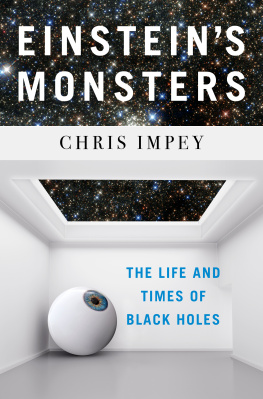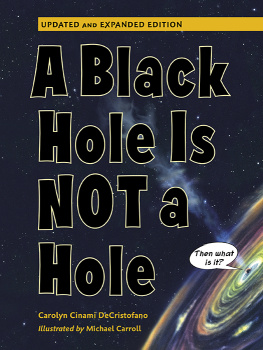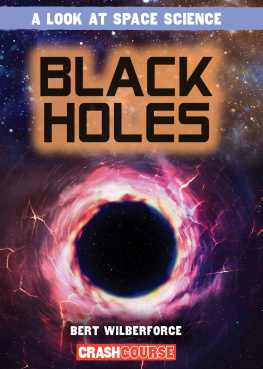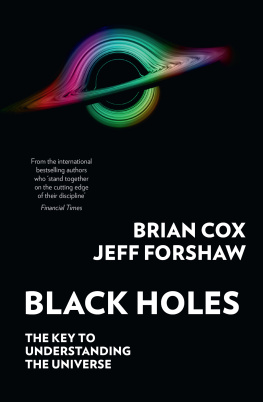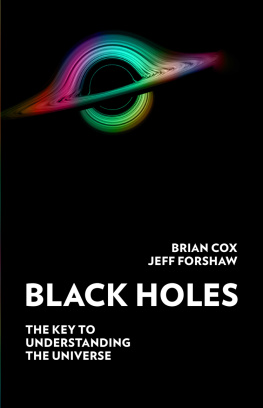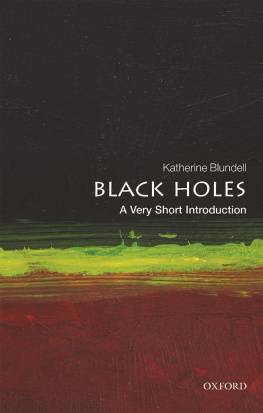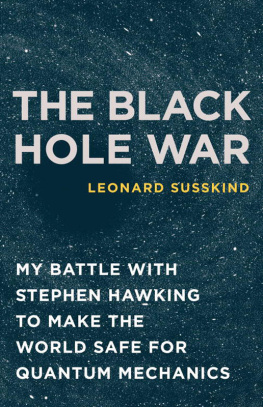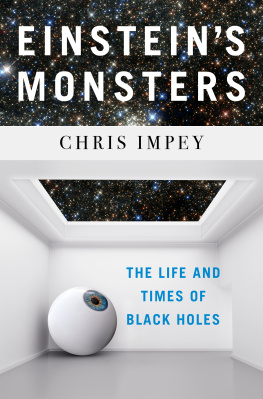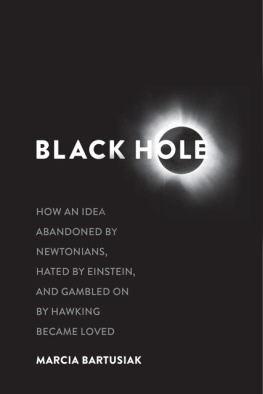Contents

ALSO BY CHRIS IMPEY
Humble Before the Void
Shadow World
Dreams of Other Worlds
How It Began
How It Ends
The Living Cosmos
Beyond

Copyright 2019 by Chris Impey
All rights reserved
First Edition
For information about permission to reproduce selections from this book, write to
Permissions, W. W. Norton & Company, Inc., 500 Fifth Avenue, New York, NY 10110
For information about special discounts for bulk purchases, please contact
W. W. Norton Special Sales at specialsales@wwnorton.com or 800-233-4830
Book design by Ellen Cipriano
Production manager: Lauren Abbate
The Library of Congress has cataloged the printed edition as follows:
Names: Impey, Chris, author.
Title: Einsteins monsters : the life and times of black holes / Chris Impey.
Other titles: Life and times of black holes
Description: First edition. | New York : W.W. Norton & Company, [2019] |
Includes bibliographical references and index.
Identifiers: LCCN 2018019192 | ISBN 9781324000938 (hardcover)
Subjects: LCSH: Black holes (AstronomyPopular works. |
GravitationPopular works.
Classification: LCC QB843.B55 I47 2019 | DDC 523.8/875dc23
LC record available at https://lccn.loc.gov/2018019192
ISBN: 978-132400-094-5 (ebk.)
W. W. Norton & Company, Inc., 500 Fifth Avenue, New York, N.Y. 10110
www.wwnorton.com
W. W. Norton & Company Ltd., 15 Carlisle Street, London W1D 3BS
To Dinah,
My love and inspiration.
Stars, hide your fires; Let not light see
my dark and deep desires.
WILLIAM SHAKESPEARE,
MACBETH, ACT 1, SCENE 4
CONTENTS
Im grateful to my wife, Dinah, for support of all my creative endeavors. Thanks go to my agent, Anna Ghosh, for steering my writing in fruitful directions. Its been a pleasure to work with Tom Mayer, my editor at Norton, and I appreciate Sarah Bollings comments on the first draft. I acknowledge the Aspen Center for Physics for its atmosphere of tranquility and intellectual stimulation that is so conducive to science writing. I have benefited from many conversations about black holes with my colleagues at the University of Arizona and around the world. Their excitement reminds me that the universe is a wondrous place. Its a privilege to be a scientist and educator and share that excitement with others.
Black holes are the best known and least understood objects in the universe. The term is used colloquially to talk about an entity that sucks in everything around it. Black holes appear onscreen and in fiction; theyve been co-opted by pop culture. A black hole is shorthand for something enigmatic, with a sinister edge. I call them Einsteins monsters as a metaphor. They are powerful and beyond anyones control. Einstein did not create black holes, but he developed the best theory of gravity that we have for understanding them.
What most people think they know about black holes is wrong. Theyre not cosmic vacuum cleaners, sucking in everything in the vicinity. They only distort space and time very close to their event horizons. Black holes represent a small fraction of the mass of the universe, and the nearest examples are several hundred trillion miles away. Its unlikely that they can be used to time-travel or visit other universes. Black holes arent even black. They emit a fizz of particles and radiation and most are part of binary systems where gas falling in heats up and glows intensely. Black holes arent necessarily hazardous. You could fall into the black hole at the center of most galaxies and not feel a thing, although youd never get to tell anyone what you saw.
This book is an introduction to black holes, large and small. Black holes are deceptively simple, but the math needed to understand them is fiendishly complex. Well meet scientists who revealed black holes to humankind, from theorists who dared dream of dark stars hundreds of years ago to those who wrestled with general relativity, and beyond.
Black holes cannot be understood without Einsteins theory of general relativity, developed a century ago, which says that space and time are distorted by matter. In the extreme case where mass is highly concentrated, a region of space is pinched off from the rest of the universe and nothing can escape, not even light. Thats a black hole. But even Einstein was skeptical of their reality. He was not alone; many notable physicists doubted that they existed.
They do exist. Evidence has accumulated for forty years that when massive stars die, no force in nature can resist the gravitational collapse of their cores. A gas ball 10 times the size of the Sun crunches down to a dark object the size of a small town. More recently, its become clear that the center of every galaxy contains a massive black hole, ranging in mass over a factor of a billion.
Examining where black holes live, well learn about binary systems, where a black hole is in a gravitational waltz with a normal star. Well see that the best evidence for any black hole is at the center of our own galaxy, where dozens of stars swarm like angry bees around a dark object 4 million times the mass of the Sun. When the massive black holes that all galaxies harbor rouse from their slumber and begin feeding, they can be seen across distances of billions of light years. These gravitational engines are the most powerful sources of radiation in the universe.
Recently, physicists have learned to see with gravity eyes by detecting gravitational waves. When two black holes collide, they release a cymbal clash of ripples in space-time that race outward at the speed of light and contain information about the violent encounter. A new window has opened onto black holes and all situations where gravity is strong and changing. Gravitational waves provide unequivocal proof, if any were still needed, that nature makes black holes. Every five minutes, a pair of black holes merges somewhere in the universe, pouring gravitational waves out into space.
Were far from knowing everything there is to know about black holes. They continue to surprise and delight. Black holes allow general relativity to be tested in new ways. Nobody knows if these tests will affirm the theory or lead to its downfall. There is vigorous debate over information loss in black holes and whether or not the information is somehow coded on the event horizon. Theorists hope that black holes may be places where string theory can be verified, finally realizing Einsteins quest to unify quantum mechanics and general relativity.
This book has two parts. The first covers the evidence we have that black holes exist. This evidence spans a range of black holes, from those not much more massive than the Sun to leviathans the mass of a small galaxy. The second explains how black holes are born and die. It also explains how black holes push our theories of nature to the limit. Along with the stories of black holes, there are personal stories, including some of my own, as a reminder that while science is dispassionate, scientists are made of flesh and blood, with all the flaws and foibles that entails. As I am covering research in a fast-moving subject, some results quoted here may not stand the test of time. Any resulting errors, omissions, or misrepresentations are mine alone.
We can imagine that intelligent creatures on many of the trillions of habitable worlds in the cosmos have deduced the existence of black holes. Perhaps some have learned how to make them and harness their power. Humans are a young species, but we can be proud to be members of the special club that knows of black holes.

